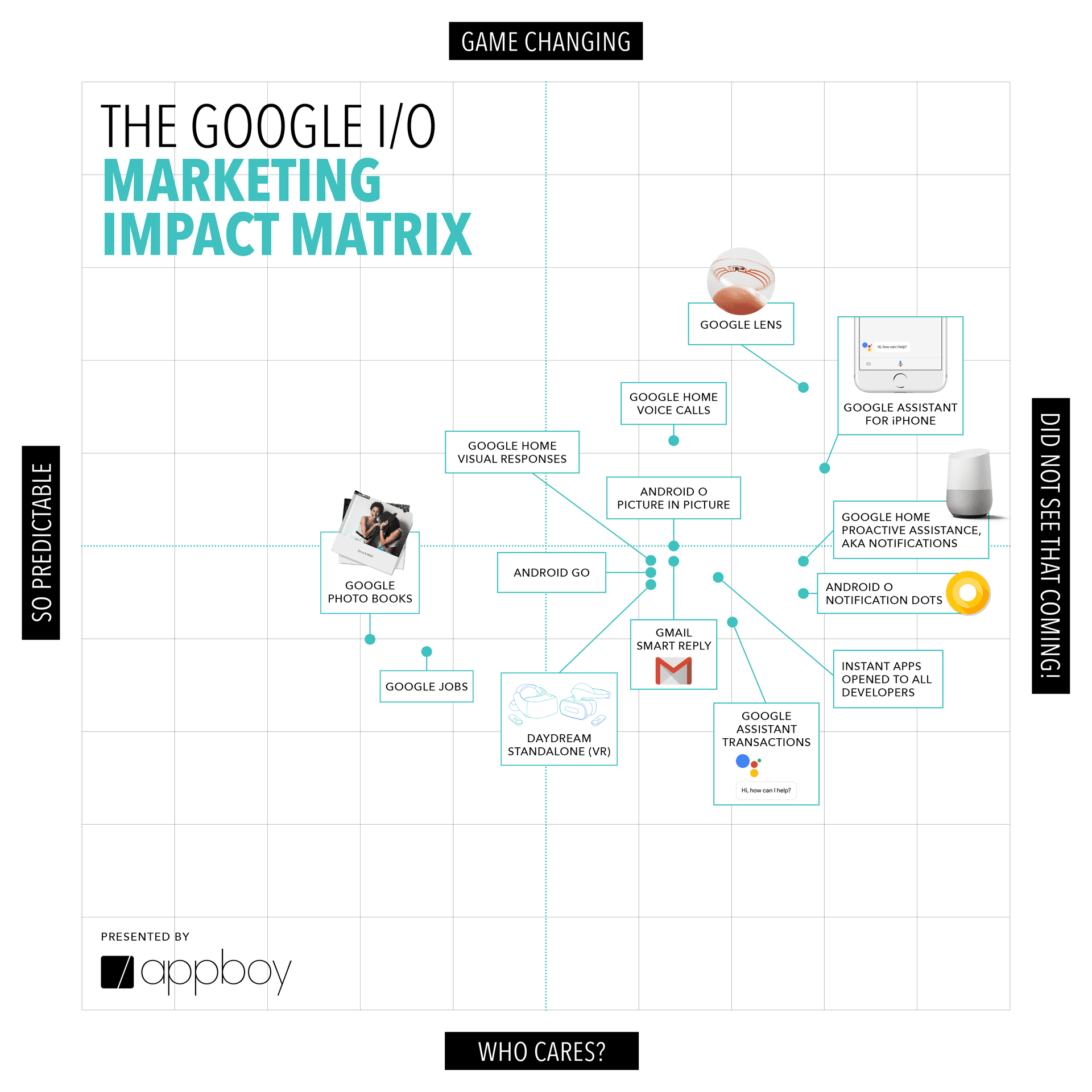Notification Proliferation: Google I/O 2017 Marketer Insights
Published on May 22, 2017/Last edited on May 22, 2017/4 min read


Team Braze
Well, the biggest news last week didn’t come from Google I/O, but that doesn’t mean the developer-centric event didn’t have its moments. Google announced a variety of new products and features, but we’re most excited about the developments around Google Assistant, Google’s advancements in AI, Instant Apps, and the new Notification Dots feature that joins the previously announced enhancements to notifications for Android O.
We took an informal poll of industry thought leaders and Appboy-ers to see which announcements were the most surprising and the most potentially impactful, then we did what all good marketers do and plotted the results on a matrix. See below and keep scrolling for more analysis on Google I/O 2017.

Hello, Notification Dots
For marketers, Notification Dots were among the most surprising announcements. Notification Dots, AKA badges, give brands and users yet more ways to stay notified. Unlike in iOS, badges won’t display the number of unread messages until a user long presses on the app icon to view/act on those notifications from the badge—the ability to act directly from the badge is unique to Android, though. Users can control which apps they want to see badges for and which they don’t. A thoughtful, holistic push notification strategy lays the important groundwork for dots that are helpful, not annoying.
Wilson Kriegel, CBO at PicsArt adds: “At PicsArt, we’re very excited about the Google I/O announcements and the upcoming Android O launch. We’re especially interested in Notification Dots and how they’ll help us deliver a richer notification experience for our global Android community. As our user base nears 100 million monthly active users, it’s important for us to deliver more timely and relevant notifications dependent on a user’s activity, personal network and their interaction with others on PicsArt.”
Overall, Android O gives users, and brands, more control over how they experience notifications. Snooze and channels were previously announced and we covered them in depth in our article on the dawn of the partial opt-out. Snooze does what it sounds like, allowing users to easily ignore notifications for now but interact with them later, while channels allows users to control the settings of a subset of notifications from any given app (for instance by topic; the app developer sets these channels). This is all great in theory, but keep in mind not every user wants to spend hours customizing their notification settings—these features are certainly no excuse to send more blast messages.
Instant Apps and the Blurring of Mobile Web and Apps
The much hyped and little actualized Instant Apps are now available to all developers. Whether Instant Apps and/or Progressive Web Apps become well-adopted is to be determined, but Google signaled they’re continuing to invest and push forward a more integrated vision of mobile web and apps, one where apps can be streamed without being installed (Instant Apps) and where the mobile web can behave for functionally for mobile use cases (Progressive Web Apps).
Aaron Sapp, mobile product manager at Everything But The House (EBTH) writes, “Instant Apps will also be a great way to transition our Android users from the browser to a native app.”
If this takes off, it holds promise for web push on mobile, especially great for brands who don’t have mobile apps, or have lots of mobile users who haven’t adopted those apps.
Google Assistant and Google Home
Start a conversation with Google Home, complete the experience on your Chromecast connected TV or smartphone. This makes sense. Start an order online, pick it up in store. Experiences like these combine channels and platforms seamlessly, and reflect the reality of how we live now: constantly switching between screens, devices, locales, and other contexts. Amazon, Google, Apple, and Facebook are all fighting to best connect these experiences and get the most brands and users on as many of their devices, apps, and services as possible. To that end, Google Assistant is now available on iPhone.
Marketers who best take advantage of these rapidly evolving technologies and platforms, accounting for complex use cases where users shift contexts and devices, stand to become truly indispensable brands in their customers’ lives. As Google and marketers continue to innovate, we’ll be there with the tips, best practices, data, and insights to help guide you on your increasingly complicated and rich opportunities to engage your users and customers. Speaking of, consider signing up for our weekly newsletter, Relate Weekly, if you haven’t already.
Be Absolutely Engaging.™
Sign up for regular updates from Braze.
Related Content
View the Blog
How AI Decisioning Transforms Marketing (A Complete Guide)

Team Braze

AI decisioning cheat sheet: How to crawl/walk/run with BrazeAI Decisioning Studioᵀᴹ

Team Braze

A day in the life of a data scientist on the BrazeAIᵀᴹ forward-deployed engineering team
